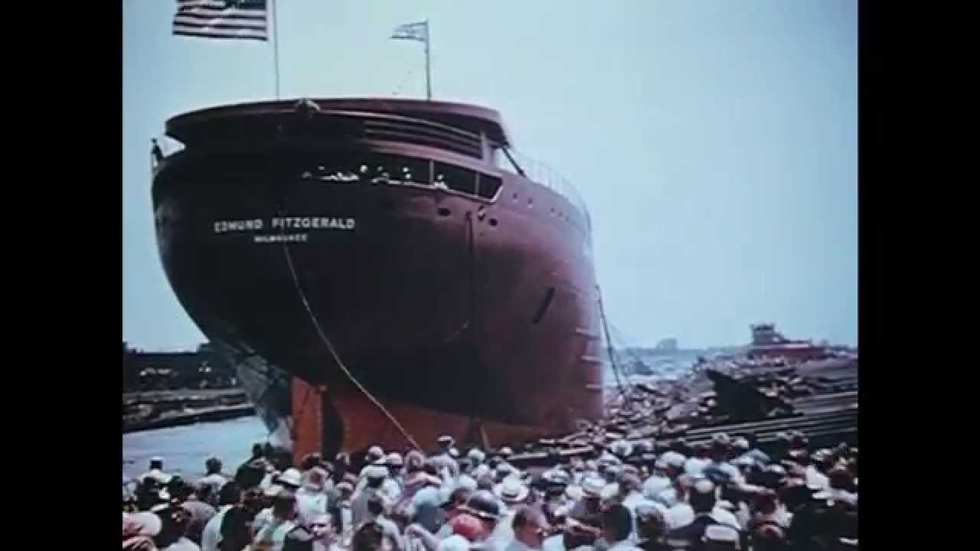The Edmund Fitzgerald was first launched on June 7, 1958 and was the largest ship on the Great Lakes. The Fitzgerald often carried material known as taconite iron ore melted down into marble sized balls from mines in Minnesota to Detroit, Michigan, Toledo, Ohio, and other Great Lakes ports. People would often gather at the ports to watch her pass by, she was quite the sight to see. She was known for setting seasonal haul records, often breaking her own records. On November 9, 1975, she left Burlington Northern Railroad Dock No.1, Superior, Wisconsin carrying 26,116 long tons of taconite pellets at 2:30 pm. Captained by Earnest M. McSorely, she seemed to be in tip top shape and ready for her voyage to Zug Island near Detroit, Michigan. She met up with another ship, the Arthur M. Anderson captained by Bernie Cooper.
As the weather continued to worsen with winds gusting up to 50 knots and seas at 12 to 16 feet, both captains remained undeterred, they’d had weathered storms such as this before. BY early afternoon on the 10th the Fitzgerald has passed the Michipicoten Island and was nearing Caribou Island. The Anderson was about 3 miles off the West End Light. Cooper Said that he watched The Fitzgerald pass too close to Six Fathom Shoal to the North of Caribou Island He could easily see the ship and the beacon on the island. With his radar set he could also measure the distance between them. Both the captain and his officers claim that they could see the ship pass into the dangerous shallow waters.
Radio communications were frequent between the two ships. Fitzgerald had some minor problems, a couple of vents had busted causing them to have to use their pumps, but nothing alarming. By that afternoon winds were NW x W at 58 knots with gusts to 70 knots, and seas of 18 to 25 feet. At about 7 pm a huge wave engulfed the Anderson, crashing into the back of the pilothouse, causing the bow to nosedive into the sea. Cooper stated, “Then the Anderson just raised up and shook herself off all that water – barrooff – just like a big dog. Another wave just like the first one or bigger hit us again. I watched those two waves head down the lake towards the Fitzgerald, and I think those were the two that sent him under.”
First mate Morgan Clark was the last to have any contact with the Edmund Fitzgerald. It was around 7:10 pm and they were discussing some vessels that were up ahead on the radar, making sure that the Fitzgerald was going to be able to clear them. Here is the transcript from their radio conversation:
“Fitzgerald, this is the Anderson. Have you checked down?”
“Yes, we have.”
“Fitzgerald, we are about 10 miles behind you, and gaining about 1 1/2 miles per hour. Fitzgerald, there is a target 19 miles ahead of us. So the target would be 9 miles on ahead of you.”
“Well,” answered Captain McSorley, “Am I going to clear?”
“Yes, he is going to pass to the west of you.”
“Well, fine.”
“By the way, Fitzgerald, how are you making out with your problems?” asked Clark.
“We are holding our own.”
“Okay, fine, I’ll be talking to you later.” Clark signed off.
Below you will find a link to the full transcript.
The radar signal, or “pip” of the Fitzgerald kept getting obscured by sea return. And around 7:15 pm, the pip was lost again, but this time, did not reappear. Clark called the Fitzgerald again at about 7:22 pm. There was no answer.
On November 10, 1975 29 men lost their lives to Lake Superior. The ship now sits 535 feet below the surface of the lake. There is still no known reason for the ships sinking, some say that the hatch was not closed properly, some believe it could be because they took on too much water. All we know is that the largest ship to ever sail the Great Lakes lies at the bottom of Lake Superior for reasons unknown to us.
http://www.shipwreckmuseum.com/edmund-fitzgerald/the-fateful-journey/

















